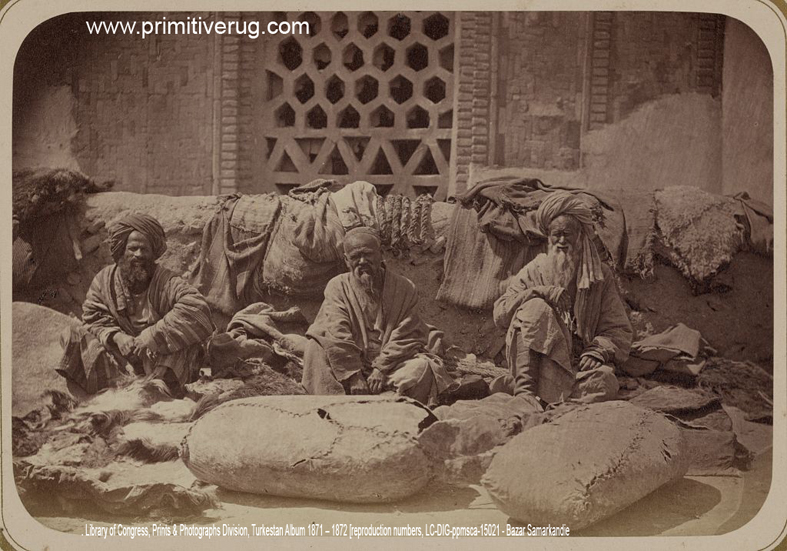Primitive Skins from the Stone Age Part 3
In 1916 E. Nelson Fell wrote:
One day I saw a man slaughtering a sheep and I jauntily said to him.......
"Aha; you will have a good supper tonight. 'Nonsense' he said 'I am making a pair of boots.' 'Of course' said I 'how stupid of me, the skin will make good boots.' 'That is not the way to make boots' and he looked at me in surprise and pity. 'You must take the entrails of the sheep and draw it into fine strings like dombra strings, and with these you can card the wool and then make felt shoes like these. I made these myself,' he said, pointing to the pair of felt overshoes on his feet. In the same manner the Kirghiz are extraordinarily clever along their own line of workmanship. The community starts with the camel, the sheep, the ox and the horse, and from these, as they and their families wander over the Steppes, they evolve their tents, their clothes, their embroideries." 1
E Nelson Fell observed the Kirghiz of the "Russian Steppes", animal skins were high on the list of items necessary for survival. The Kirghiz of the Wakhan Corridor shared the same approach to the use of animal skins.
"Rucker was in great glory. On his feet were huge felt linings encased in Kirghiz-made leather boots with silver mountings. On his legs were sheepskin trousers, untanned, having the wool inside, and these were tucked into his boots. We began to dress ourselves. We drew on our shoes, three pair of them - first a loose pair of thin embroidered leather boots (with moccasin soles), then felt boots (peemies) of solid wool about one inch thick, and then stout leather boots, all coming well over the knee. Next a short over-coat to the knee, lined with curly wool sheepskin - then the dacha, a huge overcoat of horse-skin outside and fox-skin inside, coming to the ground, with a collar which when turned up reached to the top of one's head and so voluminous that it could be wrapped nearly twice round one's body. Then with a huge wolf-skin rug, we were ready." 2
Tanning was widespread amongst Nomads and people of the cities and towns in Central Asia during the 19th and 20th Century. The use of animal hides was widespread amongst the Kirghiz of Kyrgyzstan and generally in Uzbekistan and Afghanistan,3 Kungrat Uzbeks were particularly noted for their pieced sheepskin mats, Hasali Pustak4. The Kirghiz Pieced - Skin Covers discussed in recent posts are one adaptation of a widespread practice in Central Asia.
IMAGES: Library of Congress, Prints & Photographs Division, Turkestan Album 1871 – 1872 [reproduction numbers, LC-DIG-ppmsca-15021] - Bazar Samarkandie
REFERENCES:
1. Nelson Fell. E Russian and Nomad Tales Of The Kirghiz Steppes London Duckworth & Co 3 Henrietta Street, Covent Garden Cornell University Library, 1916
2. ibid.,
3. Pedersen. G Afghan Nomads in Transition Thames and Hudson 1994 111 (The animals supply wool, skins, milk)
4. Elmira Gyul confirmed that Hasali Pustak's - pieced skin mats were made by Kungrat Uzbeks and posted images on facebook, taken at Boysun in southern Uzbekistan "Uzbek Kungrats make pustaks (hasali pustaks) up to now - Surkhandarya, south Uzbekistan." Also Karmysheva, B.Kh.: On the History of population Formation in the Southern Areas of Uzbekistan and Tajikastan (Ethnographic Data). Moscow 1964; noted that the same pieced skin rugs were made in Kizyl Cha by Uzbeks, approximately 100 kilometres west of Boysun.
